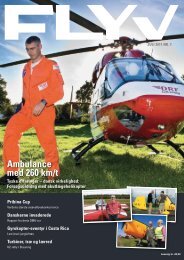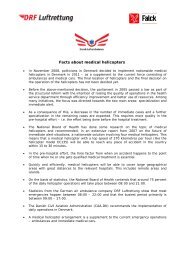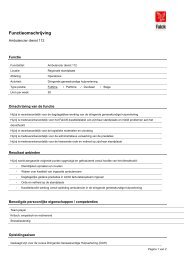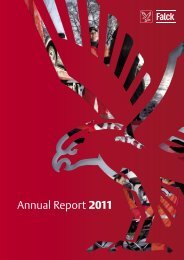Annual Report 2010 - Falck
Annual Report 2010 - Falck
Annual Report 2010 - Falck
Create successful ePaper yourself
Turn your PDF publications into a flip-book with our unique Google optimized e-Paper software.
Notes to the Group financial statements<br />
Note<br />
1 Accounting policies (continued)<br />
Deferred tax is measured using the tax rate expected to apply<br />
when timing differences are reversed. Changes in deferred tax<br />
as a result of changes in tax rates are recognised in the income<br />
statement.<br />
BALANCE SHEET<br />
NON-CURRENT ASSETS IN GENERAL<br />
Intangible assets and property, plant and equipment, except<br />
for goodwill and other intangible assets with indefinable<br />
useful lives, are measured at cost less accumulated straightline<br />
amortisation and depreciation and impairment losses.<br />
Goodwill and intangible assets with indefinable useful lives are<br />
measured at cost less accumulated impairment losses. Amortisation,<br />
depreciation and impairment losses are recognised in<br />
the income statement.<br />
The basis of depreciation is calculated with due consideration<br />
to the asset’s scrap value, reduced by any impairment losses.<br />
The scrap value is determined at the date of acquisition and<br />
revalued each year. Where the scrap value exceeds the carrying<br />
amount, the property ceases to be depreciated.<br />
If the amortisation or depreciation period or the scrap value<br />
is changed, the effect on amortisation or depreciation going<br />
forward is recognised as a change in accounting estimates.<br />
Cost includes direct costs related to the asset and the initial<br />
estimate of the costs related to dismantling and removing<br />
the item and restoring the site on which it is located, if the<br />
costs meet the definition of a liability. Cost further includes<br />
borrowing costs from specific and general borrowings directly<br />
relating to the acquisition, construction or development of<br />
the individual qualifying asset.<br />
Where parts of an item of property, plant and equipment<br />
have different useful lives, they are accounted for as separate<br />
items.<br />
Each year, the assets are reviewed in order to assess whether<br />
there are indications of impairment. If such indications exist,<br />
the recoverable amount, determined as the higher amount<br />
of the fair value of the asset adjusted for expected sales costs<br />
and the value in use of the asset, is calculated. The value in<br />
use is calculated based on the estimated future cash flows, discounted<br />
by using a pre-tax discount rate that reflects current<br />
market assessments of the time value of money and the risks<br />
specific to the assets.<br />
Group | <strong>Falck</strong> <strong>Annual</strong> <strong>Report</strong> <strong>2010</strong> 61<br />
If the recoverable amount of an asset or its cash-generating<br />
unit is lower than the carrying amount, the asset is impaired.<br />
Any impairment loss is recognised in the income statement.<br />
In addition, for goodwill and other intangible assets with indefinable<br />
useful lives, impairment tests are performed at each<br />
balance sheet date, regardless of whether there are any indications<br />
of impairment. For acquisitions, the first impairment test<br />
is performed before the end of the year of acquisition.<br />
Impairment losses are reversed if the recoverable amount increases.<br />
Impairment losses will only be reversed to the extent<br />
that the value in use does not exceed the carrying amount of<br />
the asset if the impairment had never been made. Impairment<br />
losses of goodwill are not reversed.<br />
Intangible assets<br />
Goodwill is recognised in the balance sheet at cost on initial<br />
recognition as described under “Business combinations”.<br />
Goodwill is subsequently measured at cost less accumulated<br />
impairment. Goodwill is not amortised.<br />
Intangible assets acquired on acquisition are measured at cost<br />
less accumulated amortisation and impairment. Intangible assets<br />
acquired on acquisition are amortised over the expected<br />
economic life, estimated to be 3 to 10 years.<br />
Other intangible assets are measured at cost including costs<br />
which can be directly or indirectly attributed to the assets in<br />
question.<br />
Other intangible assets include software, etc.<br />
Software is amortised over the expected economic life, estimated<br />
to be 3 to 5 years. For major administrative systems,<br />
the economic life is estimated to be 8 years.<br />
Property, plant and equipment<br />
Land and buildings are measured at cost less accumulated<br />
depreciation and impairment of buildings.<br />
Depreciation of buildings is calculated on a straight-line basis<br />
over the expected useful lives of the assets, estimated to be<br />
between 25 and 33 years. Certain installations are depreciated<br />
over ten years.<br />
Leasehold improvements are depreciated on a straight-line basis<br />
over the term of the lease.




